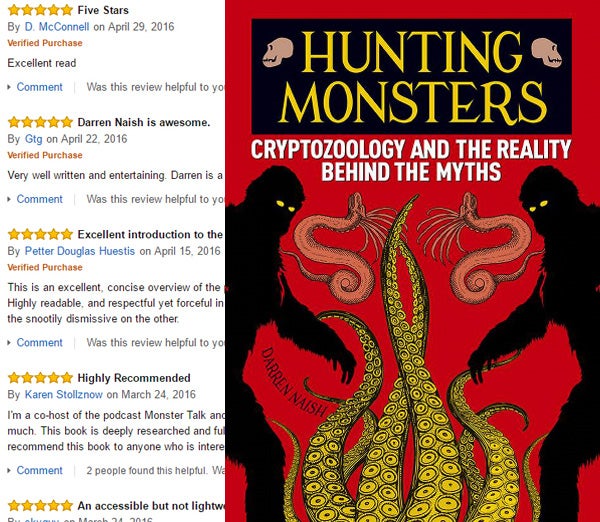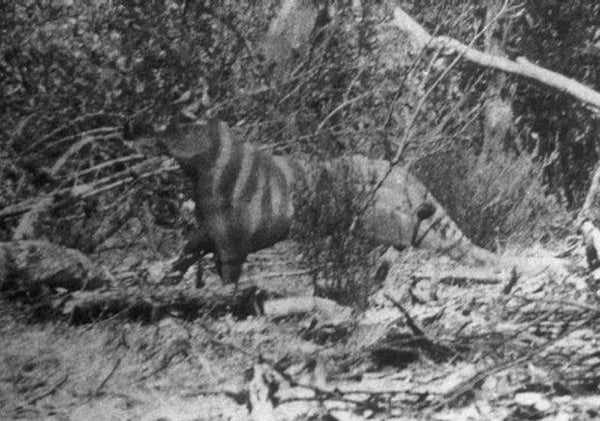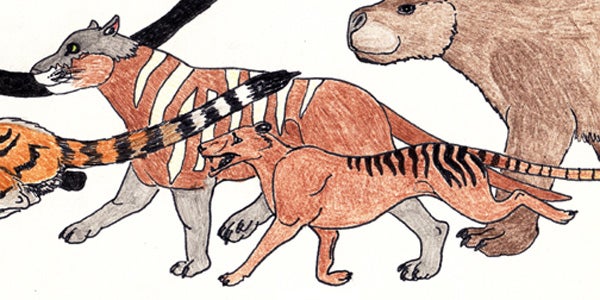This article was published in Scientific American’s former blog network and reflects the views of the author, not necessarily those of Scientific American
Regular, long-time readers will recall the 2010 article published at Tet Zoo ver 2 in which I discussed the curious case of Rilla Martin’s ‘Ozenkadnook tiger’ photo – a photo thought to depict a large mystery marsupial that doesn’t match any species known to science. I really hadn’t realised that six years had passed since the appearance of that article (as usual, I was thinking of it as a ‘recent’ article)… Anyway, has anything interesting happened since then? Well, no. However, I did write about the case in my book Hunting Monsters (Naish 2016), and, below, you’ll find what I said. Hunting Monsters is currently only available as a ebook but a print version (containing various minor corrections and updates) is currently in press and due to appear sometime around April 2017.

Hunting Monsters has mostly been received quite well... though there are, of course, those who dislike it very much. Credit: amazon.com
In 1964, Rilla Martin was driving along a countryside road near Ozenkadnook in western Victoria when she apparently caught sight of a dog-sized, striped animal in the woods at the side of the road. She happened to have her box Brownie camera right next to her, and succeeded in taking a single image of the creature as it ran from right to left. Local sightings of a striped animal thought to be a mainland thylacine had already led to the idea of a creature dubbed the ‘Ozenkadnook tiger’, and Martin’s photo has consequently become known as the ‘Ozenkadnook tiger photo’. However, the creature in her photo doesn’t look at all thylacine-like: it has tall shoulders, a deep, short-snouted head, and broad, pale stripes.
On supporting science journalism
If you're enjoying this article, consider supporting our award-winning journalism by subscribing. By purchasing a subscription you are helping to ensure the future of impactful stories about the discoveries and ideas shaping our world today.

The original photo, though note that it's of unknown whereabouts and we only have copies in books and so on to go on. Credit: ScienceBlogs
In view of these features, the suggestion that Martin encountered and photographed a live marsupial lion has been made on occasion, and some researchers have even claimed that the shape of the creature’s head matches such an identity quite well. The possibility that the case was a hoax, and that a cut-out shape of a tiger-like animal was posed in the bush and photographed, has also been made. Martin’s brother denied this possibility as recently as 1999. The fact that the creature is so hard to interpret does suggest the possibility of a hoax. Furthermore, Martin’s supposed ability to stop driving, erect her box Brownie camera, and then take a reasonably good photo of a running animal is slightly suspicious. Taking photos of running animals from a moving car is maddeningly difficult even with a modern point-and-shoot digital camera that takes a second or two to fire up.
The ideal way of resolving – or, at least, of trying to resolve – this case would be to examine the original photo. But it was lost by the newspaper that borrowed it during the 1960s, meaning that we only have reproductions from books, magazine articles and newspapers. For now, we can go no further with the image, meaning that all we have is conflicting opinions on its veracity. Martin herself was interviewed on camera and versions of this recording are available to researchers today. Her behaviour and speech is convincing overall, but there are a few tiny quirks in body language that – some suggest – might imply that she was not being completely truthful when answering questions.

Speculative rendition of Rilla Martin's creature, shown alongside a thylacine and other animals. Credit: Darren Naish
As is the case with so many of these stories, we’re almost certainly never going to be able to determine the ‘truth’ at the bottom of this case. While some researchers cling to the idea that Martin photographed a unique animal that was perhaps a modern-day Thylacoleo, the ambiguity and weirdness of her photo, combined with the incredible fortuity of her apparent blind luck in taking that photo, strongly suggest that it was indeed a hoax.

A selection of books that focus on (or cover) Australasian mystery animals. Some have really awesome covers. Credit: Darren Naish
Let me finish by saying that, while Hunting Monsters does not cite sources within the body of the text, it does have reference sections at the end of each chapter. Sources consulted during the preparation of the Ozenkadnook tiger case included Shuker (1989), Healy & Cropper (1994), Smith (1996) and Williams & Lang (2010). Rebecca Lang kindly provided me with interview footage featuring Rilla Martin.
For previous Tet Zoo articles on Hunting Monsters and on Australian mystery animals, see...
Refs - -
Naish, D. 2016. Hunting Monsters: Cryptozoology and the Reality Behind the Myths. Arcturus, London.
Shuker, K. P. N. 1989. Mystery Cats of the World. Robert Hale, London.